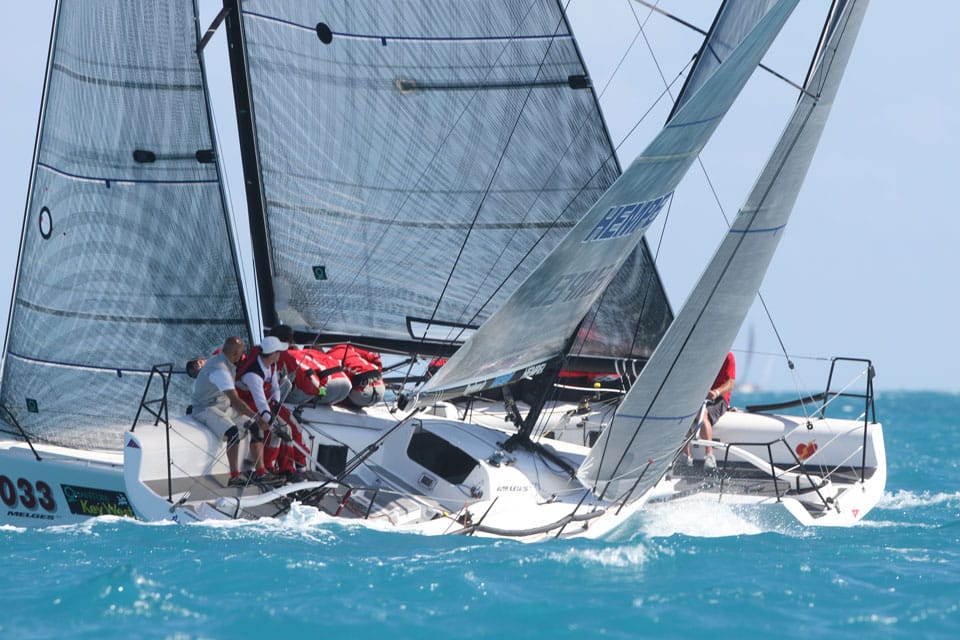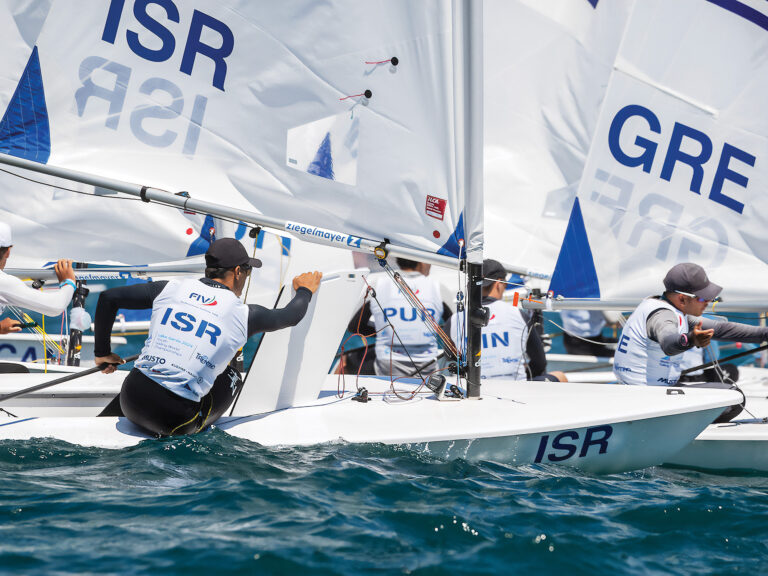
Control the Cross
At a recent regatta, a port-tack boat was making a close cross and its team yelled, “Tack or cross?” But, I’d already decided what I wanted them to do.
“Duck!” I yelled back.
I’m sure it wasn’t the response they were hoping for. Perhaps it sounded flippant. But why should I let the give-way boat control my destiny by asking me to pick between two options? There is, after all, a third.
The port-starboard cross, especially when the port boat is anywhere from a half length ahead to barely crossing, can be critically important to both boats. The desired outcome for either competitor is the ability to execute their respective game plan no matter how the other boat reacts. The key, whether you’re on port or starboard, is to avoid leaving the final result to the whim of your competitor.
The question “Tack or cross?” is usually a last resort when a cross is too close for comfort. Allowing a race strategy to hinge on the answer can be a death sentence. When you ask “Tack or cross?” you put the outcome in the hands of the right-of-way boat.
By breaking down this simple situation into fundamental strategies and potential outcomes, you can improve the likelihood of coming out of a cross with the upper hand.
In a basic port-starboard run-in, the intent of the port-tack boat is usually to continue to the right side of the racecourse, while the starboard-tack boat wants to continue to the left. Or, the starboard boat may be looking to harass port and maintain control of the right. Rule 10 says that port must keep clear of starboard. It may be in both boats’ interests to avoid an incident altogether. But, in most port-starboard crossing situations, someone will end up with the short straw. Here’s how to make sure that someone isn’t you.
The port-tack perspective
Strategy A: The port-tack boat wants to keep going to the right side
This strategy has three options, each with its own risks and likelihood of success.
Option 1: Crossing ahead is the ideal outcome for port. That’s why so many people ask, “Tack or cross?” They are optimistic, but they’re up against an obstacle to their strategy. Asking “Tack or cross?” can solve the problem, unless starboard responds, “Tack!” Then the strategy cannot be executed and the most likely result is a rushed, possibly poor, tack. If a lee-bow tack isn’t properly placed, the port-tack boat’s get-right strategy gets nixed. Starboard will be in control, and push port to the left side.
Option 2: Ducking behind starboard is a less-than-ideal outcome for the port-tack boat, but it does have a high rate of success for executing the go-right strategy. There’s always a chance the duck doesn’t go as planned. The sailor who hasn’t nicked a starboard tacker’s transom might be the luckiest sailor alive. Also, failing to unload the vang or ease the main to allow the helmsman to bear away can cause a major collision.
A clean duck will sacrifice distance, but the associated risk of fouling the starboard-tack boat is vastly lower than with a marginal cross. It’s painful to pass behind another boat, but a minor loss to guarantee the success of a broader strategy can be a major gain. Port also gains total control of its port-tack lane because Rule 16.2 freezes starboard’s course once port starts to keep clear by passing astern. A close duck to the favored side also means that the next time the boats meet up the course, the right-of-way will be reversed.
Option 3: Leebow starboard. A well-placed tack on the starboard boat’s leebow should force it into a clearing tack. There are risks with this option. Two tacks will be required to continue right. If the leebow attempt fails, the starboard boat will be able to continue left, and take port along for the ride.
Strategy B: The port-tack boat wants to control the left**
Having discussed the plan to leebow and prepped the team for the maneuver, the port-tack team should get a good look at the starboard boat to ensure a good tack under starboard’s bow, and then get up to speed quickly after the tack to preserve the new lane and slow starboard as much as possible. Stick with your decision regardless of starboard’s actions. If your plan is to leebow, and the starboard crew yells for you to cross; execute the leebow and race on. A late change in plans is just as risky as putting the decision off until too late.
The starboard-tack perspective:
Strategy A: Starboard wants the left side of the racecourse
The starboard tacker must make his intentions known early and clearly. Allow a port-tacker to cross, and they almost always will. Ask a crewmember to step to leeward and wave them across. Make sure both boats are aware of the plan. This is the ideal scenario for a starboard tacker that wants the left. Simply make a small duck, and sail off according to plan.
Strategy B: Starboard wants to continue left, and keep control of the port-tack boat
There’s a risk in forcing port to tack: a windward boat will always struggle to hold its lane against a leeward boat positioned bow-even or bow-ahead. This choice requires careful analysis of exactly how far starboard needs to continue after the port-tack boat tacks on his leebow. This strategy is best suited when close to the port-tack layline. However, the shorter the distance to the layline, the greater the chance that port will execute a late duck and lock starboard’s course under Rule 16.2.
The key is to make the call early. By bearing away slightly when six boatlengths away, starboard increases the closing speed, which forces the port boat to reassess its time-and-distance calculation and can fluster them into a bad tack. As soon the port boat begins its tack clear to leeward of starboard’s temporarily lower course, starboard should return to its closehauled course and create a lane of clear air in which to continue.
Strategy C: Starboard is looking for an opportunity to tack
The best option for a starboard-tack boat here is to force the port-tack boat to tack and then tack into the lane it once occupied. Hailing “Starboard” is standard practice. Pointing at the port-tacker and then in the direction you want them to sail is generally effective. But refrain from saying “No!” or “Yo!” or “Hey Joe!” as they can be easily misheard as “Go!”
Because starboard’s intention is to tack as soon as port keeps clear, it’s important to discuss the plan with the team before port gets too close. Then, as soon as it’s clear that port is tacking to leeward, the tack can start. Don’t show that you’re going to tack too soon, otherwise port may adjust its strategy.
It’s important to note that while starboard has the advantage and port must keep clear, port can freeze starboard once she starts to duck. Rule 16.2 restricts starboard from changing course while port is on a course to pass astern (ducking) if it means port has to immediately change course to keep clear.
All of these strategies and execution plans seem easy enough when broken down into individual discussion points. The challenge is that all the contingencies are possible every time two boats meet on opposite tacks. If you assess each situation individually, keep in mind your long-term goal for the leg, discuss the other boat’s options, and then make your plan based on each of those contingencies, you can control your own destiny.









